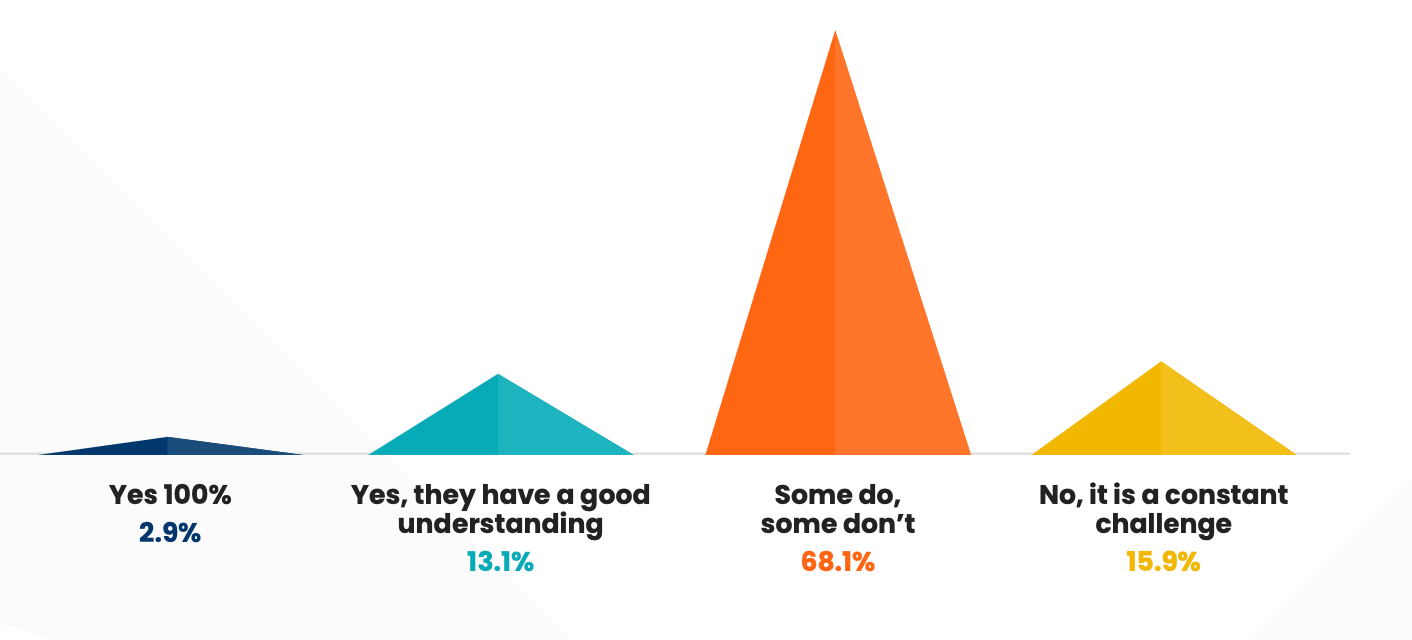Our new report reveals that while companies are valuing customer marketing more, there’s still a major gap in understanding exactly what the role entails and how it drives revenue.
The 2023/24 State of Customer Marketing Report surveyed over 100 professionals to uncover the latest trends and insights.
A key finding is that only 3% of respondents feel fully understood by their companies and colleagues. At the same time, over 75% rated their role as valued at a 6 or higher on a scale from 1 to 10.
This dilemma highlights an ongoing challenge: customer marketing plays an invaluable part in business success, yet others often misunderstand it.
As leaders increasingly recognize the revenue potential in customer retention and expansion, they must also educate themselves on how customer marketers are the ones to make that happen.
Why customer marketing matters
Customer marketing focuses on building loyalty and advocacy with existing customers through highly personalized experiences based on in-depth customer insight.
Ultimately, the goal is to turn happy customers into vocal brand promoters.
The numbers speak for themselves in terms of impact:
- 80% of future revenue comes from just 20% of existing customers
- Increasing retention rates by just 5% boosts profits by 25-95%
- 60-70% chance of selling to an existing customer vs. 5-20% for a new one
- Existing customers spend 31% more than new ones
Companies taking a customer-led approach to their tech investments grow 1.8x faster than their peers and customer-obsessed companies grow 2.5x faster than non-obsessed ones and retain 2.2x more customers annually.
With such impressive potential for revenue and growth, it's no wonder over half of respondents want to progress upward in their customer marketing career in the next year.
However, this progress hinges on internal stakeholders truly recognizing why the function matters.

Where understanding falters
Out of our participants, 68% stated, about their companies understanding, that "some do, some don't" have a proper grasp of their position. Meanwhile, 16% called it "a constant challenge."
The ambiguity we picked up in our report seems to stem from the fact that customer marketing is still establishing itself as a distinct role.
Tasks often overlap with sales, marketing, product, and customer success teams. However, the focus on post-purchase makes responsibilities and goals unique.
Educating colleagues is key, but it's a two-way street. Customer marketers must also learn stakeholders' objectives to convey alignment.
Cetiera Carmona, Senior Manager of Customer Growth at BigCommerce, adds:
"It seems that so many more companies are investing in customer marketing and seeing the value in it. There’s still a lot of work to be done but it’s so encouraging seeing the growth in the industry and all of the amazing things CM teams across the world are doing to support their customers."

Proving and improving value
Positively, the average rating for "How valued do you feel?" went from 6.6 to 6.8 out of 10 year-over-year. Plus, the percentage who selected a score of 8 or above rose by 6%.
However, budget and resources don't always match this verbal support. Over 60% of participants have annual budgets under $100k, comprising less than 20% of total company marketing spend.
This is surprisingly little considering the revenue impact of retaining and expanding accounts.
To shift the needle on budget and strategic input, customer marketers must make their work less "behind the scenes" through metrics and reporting. These signals offer hard proof to reinforce positioning during planning cycles.

What customer marketers need to succeed
With growth and career ambitions high but budgets inconsistent, what empowers these professionals to make an impact regardless?
The top skills identified point to human connections, which isn't surprising given the customer marketer role description.
However, having patience and listening ability doesn't directly drive revenue. Demonstrating commercial outcomes does.
As Emily Glover, Customer Marketing Lead at Vimeo, has already witnessed:
“My team had to re-evaluate “impact” in terms of quantifiable outcomes.”
The best performers will complement emotional intelligence with business acumen, data analysis, and tools literacy. As multidisciplinary feats become more attainable through technology, customer marketers should jump on opportunities to analyze, automate, and optimize programs.
For example, over half now use sophisticated platforms and tools to manage advocacy and track engagement.
The future looks bright
While still misunderstood by many, customer marketing holds so much potential to guide companies toward sustainable profits.
As Carmona explains,
"Look for opportunities to positively impact the business beyond your current scope...This will leave a lasting impact on cross-functional stakeholders and help expand your current reach."
Everything points toward customer marketing cementing itself as a revenue driver within organizations.
Now it's time for leaders across departments to catch up on how exactly that happens through empathy, analytics, and purpose-built technology coming together.
When they do, they'll discover impressive untapped profit streams through better engaging their most valuable assets: customer marketing teams and existing buyers.





